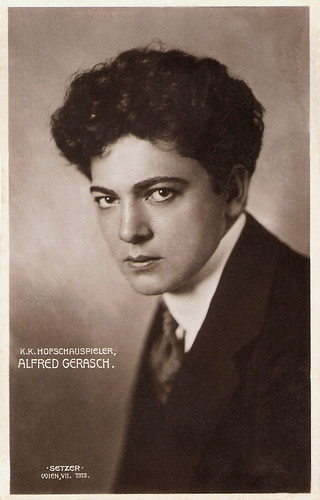
Austrian postcard by Postkartenverlag Brüder Kohn, Wien (Vienna). Photo: Setzer, Wien, 1913.
Alfred Gerasch (1877-1954) was a popular Austrian stage actor who belonged to the exclusive circle of the ‘Königlich-Kaiserlichen Hofschauspielern’ (Royal Court Actors). He also acted in several silent and sound films, often playing historical figures.

German postcard by Ross Verlag, Berlin, no. 1023/3, 1926-1927. Photo: Setzer, Wien (Vienna).
Austrian actor Walter Slezak (1902-1983) began his film career as a thin leading man in silent films. Unable to keep his weight under control, Slezak decided around 1930 to become a character actor. When the Nazis came into power he moved to Broadway and Hollywood, where he usually portrayed a villain or thug, but also played lighter, kindlier roles.
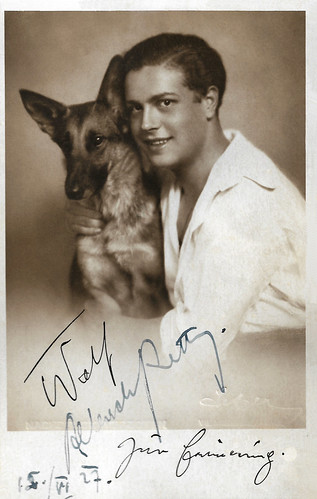
Austrian autograph card, signed in 1927. Photo: Franz Xaver Setzer, Wien.
The Austrian-German actor Wolf Albach-Retty (1906-1967) is nowadays best known as the father of Romy Schneider, but during the 1930s he was a popular leading man of German cinema.
A meeting place for the rich and beautiful, the bourgeoisie and artists
Franz Xaver Setzer was born Franz Anton Adolf in 1886 in Vienna. He received his training at the Imperial Royal Institute of Prints and Drawings. In 1909, he founded his own studio. The rooftop studio set up in 1911 in Museumstraße 5 in the seventh district soon became a meeting place for the rich and beautiful, the bourgeoisie and artists. The news that the portraits created in Setzer's well-lit studio were of the highest artistic quality had quickly spread in Vienna during the interwar years.
The ambience of "Setzer – Photographische Bildnisse, behind the German Volkstheater" – as an advertising card from early years describes the location – met the high demands and was equipped with "a lift and a telephone". Personalities from the theatre, opera and cultural scene of Setzer were portrayed in their early years. In recognition of the high quality of his work, Franz Xaver Setzer received the Voigtländer Medal of the Photographic Society in 1917.
Among the first customers before 1920 were the Royal Court actor Alfred Gerasch, composer Arnold Schönberg, the actress Hedwig Bleibtreu and the writer Stefan Zweig. He ran the studio with his future wife Friederike von Winternitz.
In 1920 Setzer married the opera singer Marie Gutheil-Schoder. This marriage expanded his social position. In addition to contemporary artists, representatives of the aristocracy, politicians and economists were increasingly included in the group of people who were photographed by Setzer.
Alternating photos show that Franz Xaver Setzer also had friendly contacts with his contemporary colleagues, such as Madame d'Ora and Arthur Benda.

Austrian postcard by Magasin Metropole, Wien. Photo: Franz Xaver Setzer, Wien.
Raoul Aslan (1886-1958) was an Austrian theatre and film actor of Greek-Armenian ancestry. For many years, he was a star at the Vienna Burgtheater. He was also the director of the famous from 1945 to 1948. Aslan was not particularly interested in films and only appeared in comparatively few productions.
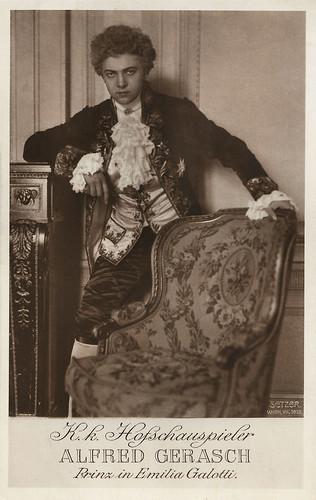
Austrian postcard by Postkartenverlag Brüder Kohn, Wien (Vienna), no. 887-1834. Photo: Setzer, Wien, 1913. Caption: K.K. Hofschauspieler Alfred Gerasch as the Prince in 'Emilia Galotti', a play in five acts by Gotthold Ephraim Lessing (1729–1781), which premiered on 8 March 1772 in Braunschweig (Brunswick).
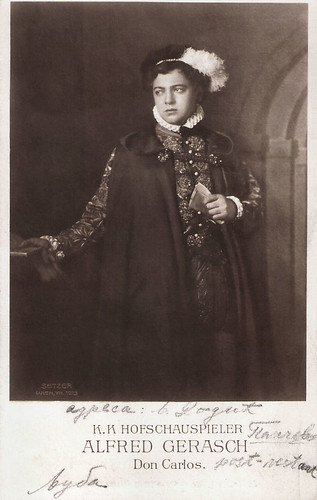
Austrian postcard. Photo by Setzer, Vienna, VII. 1913. Alfred Gerasch, 'K.u.K. Hofschauspieler (Royal and Imperial Court Actor) as Don Carlos in the homonymous play by Friedrich Schiller.
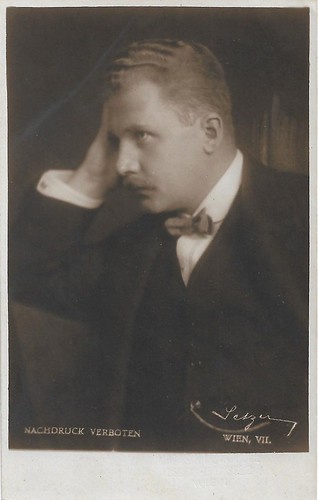
Austrian postcard. Photo: Franz Xaver Setzer, Vienna, VII.
Hans Marr (1878-1949) was a German actor and director. At the Burgtheater in Vienna, the handsome Marr was above all a hero actor and played especially in plays by Gerhart Hauptmann, with whom he was also a friend. From 1913 onwards, Marr was given film roles.
An invaluable gem of Viennese photographic history
Franz Xaver Setzer made repeated trips to Salzburg. The Salzburg Festival was an opportunity to make photos on location – for example, of Giacomo Puccini, Max Reinhardt and Maria Jeritza – as well as receiving commissions for the studio in Vienna.
In April 1920, twenty-year-old Marie Karoline Tschiedel took up a position as assistant to the artist in the studio. She had also studied at the KuK Graphische Lehr- und Versuchsanstalt and specialised in the fields of portrait photography and negative retouching.
The global economic crisis in the 1930s also affected the work in the studio. The situation deteriorated and Setzer withdrew, also for health reasons. Tschiedel, who had already worked closely with Setzer in recent years, became the technical director of the studio in 1934 and increasingly assumed overall responsibility for the studio.
At the age of 52, Franz Xaver Setzer died in January 1939 as a result of a serious illness. Marie Karoline Tschiedel took over the studio from his heirs and continued it under the name Setzer-Tschiedel. In 1945, part of the attic was badly damaged by a bomb hit.
Although the studio was not directly hit, work had to be stopped. After the end of the war, the studio was initially confiscated by the Russian occupying forces - but operations were soon resumed and continued until 1979. The studio has been preserved almost in its original condition to this day. The archive of the Setzer-Tschiedel photo studio is still family-owned today. It is an invaluable gem of Viennese photographic history and an extraordinary testimony to Viennese cultural history.
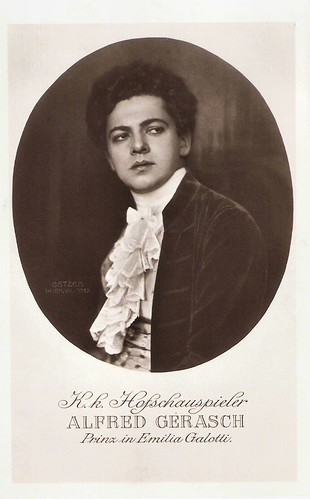
Austrian postcard by Postkartenverlag Brüder Kohn, Wien (Vienna). Photo: Setzer, Wien, 1913. Caption: Alfred Gerasch. Prinz in Emilia Galotti." (Prince in Emilia Galotti). Emilia Galotti is a play in five acts by Gotthold Ephraim Lessing (1729–1781), which premiered on 8 March 1772 in Brunswick ("Braunschweig" in German). The work is a classic example of German bürgerliches Trauerspiel (bourgeois tragedy). Lessing's work comprises an attack against the nobility and its powers. Lessing depicts aristocrats as having unfair powers in society and as ruining the happiness of the emerging middle class.

Austrian postcard by Postkartenverlag Brüder Kohn, Wien (Vienna). Photo: Setzer, Wien, 1913. Caption: "Alfred Gerasch als Romeo." (Alfred Gerasch as Romeo). Publicity still for a stage production of the play 'Romeo and Juliet' by William Shakespeare.
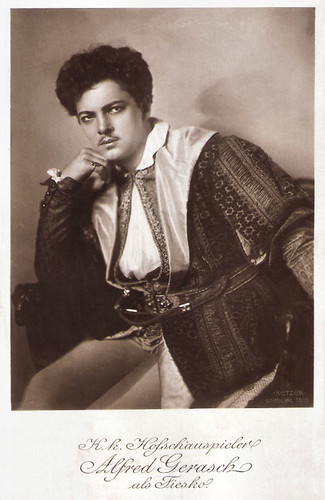
Austrian postcard by Postkartenverlag Brüder Kohn, Wien (Vienna), no. 887-1835. Photo: Setzer, Wien, 1913. Caption: K.k. Hofschauspieler Alfred Gerasch als Fiesko. Die Verschwörung des Fiesco zu Genua/Fiesco was the second full-length play by Friedrich Schiller. It is a republican tragedy based on the historical conspiracy of Giovanni Luigi Fieschi against Andrea Doria in Genoa in 1547. It premiered in Bonn in 1783 at the Hoftheater.
Sources: Wer Wien prägte (German), OTS (German), and Wikipedia (German and English).
No comments:
Post a Comment